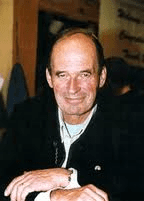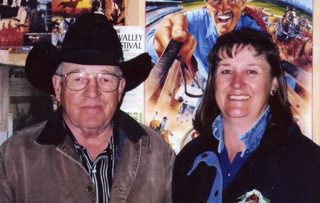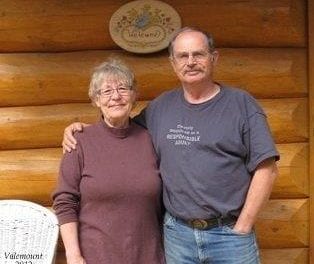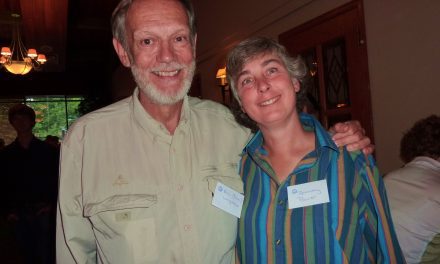Park Warden Alumni Society of Alberta Thank you to the Whyte Museum of the Canadian Rockies for granting permission to the Park Warden Service Alumni to post this interview on our website
Park Warden Alumni Society of Alberta
Oral History Project – Winter 2015
Telephone Interview with Peter Fuhrmann
January 26, 2015

Place and Date of Birth: Peter was born in Breslau, Germany, October 22, 1933.
Occupations: After completing his business education, Peter began working for Shell Oil in Germany. In search of adventure he then immigrated to Canada in 1955. He arrived in Banff that summer and starting working for the Department of Public Works as a surveyor. Peter went on to become the Regional Draftsman for the Western Region. Following the completion of his mountain guides license in 1961, he became an Alpine Specialist for Parks Canada. Peter is credited with introducing the helicopter sling rescue technique in Canada and bringing the wardens of the mountain park service to an internationally recognized rescue standard.
Additional Information: Peter Fuhrmann is a celebrated mountaineer widely recognized for his many contributions to mountain culture and community. He was an original member and the first president of the Association of Canadian Mountain Guides and he is credited with reorganizing and revitalizing the Alpine Club of Canada into the very successful organization it is today. In 2010, Peter received the prestigious Summit of Excellence Award.
“Can I please start with your place and date of birth?”
(2:17) My of birth place is Breslau, Germany…22-10-33. That is where I was born. I grew up partially in Augsburg and in Nuremberg.
“As a child did you spend much time in the mountains?
No, then I was very, very small. Then I went back to Breslau because Nuremberg was being bombed every second night. When I was in Breslau I went to…a gymnasium which is a humanistic gymnasium school. In 1945, then the Russians came and we had to flee. Then I spent two and a half years behind the iron curtain as a young boy with the Russian occupation Then in 1947 and a half, I managed to get back to Nuremberg to my parents. So I had been separated from my parents for a long, long time. I was living with my grandparents then. But I am the only child, so there was (no sibling). In 1947 and a half, I got back to Nuremberg with my parents and then I started school again. When I finished business school, I started to work for Shell Oil. Well, Shell Oil you know, the company is unbelievable.
“Is that what got you skiing?”
They had a chalet in the mountains and whenever you had your holidays you could sign up to either go climbing or you could go skiing in the wintertime. For two or three weeks, they would send you off to the chalet where there were maybe about 50 Shell employees. We all had a lift there and we all went skiing. But I had been skiing actually when I was six years old already with my cousin.
“And what brought you over to Canada?”
(6:07) Shell Oil, after the war, was run by a bunch of senior executives who had been officers or who had been connected to the Nazi party. And they were extremely, aggressively against the West because they had lost the war. I worked for Shell Oil for two and a half years and it got to a point where if you ever made any comment about the West or about the Americans, because now I was in the American zone, it was not very well accepted. So it got to a point where I just couldn’t take the bullying and the harassment anymore…I mean when you worked for Shell in Germany when I was there, you go to a tailor, a Shell tailor and he would make two grey suits for you. You were supposed to wear these grey suits in the office and if there was ever any function, you had a tuxedo and you had to wear the tuxedo, but it had to also be with the white matching tie. If you deviated from that they would send you home and tell you to get changed. Well, in North America you wouldn’t find anything like this, you know. But in Germany at the time it was the way to go. After a while I had met a fellow who worked for Shell Oil, but he had fled during the war to , England. He came back and we became friends. He basically told me that my life was not going to be Shell Oil Germany. Even though after finishing a couple more years, I would have either been sent to England or to probably South America with Shell. But I didn’t want to wait this long so I kind of got the idea that maybe I should have a look around and see what the world is like. I made an application for South Africa and that didn’t pan out. I had a very, very good friend who actually immigrated to Philadelphia and maybe I was going to go to Philadelphia? But I didn’t like the idea that you could get drafted there. Finally I figured my mother had connections to Canada being a librarian and an art dealer, so I thought, “Well, maybe I would try to go to Canada.” I got a visa for Canada and Heinz Kahl, you know the Kahl Wall on the Yamnuska? Well, Heinz was working for the Post Office in Nuremberg and we were good friends because we went to the jazz clubs every second night or whatever. Heinz said to me, “You are going to Canada? I would love to go to Canada too and get away from the Post Office deal.” It was also very, very (rigid), there was bullying and they just didn’t like young guys at all. They were all old Hitler Nazi regime type of people. My mother managed to get a visa for Heinz and we came to Canada together.
“And was that 1955?”
(11:13) 1955. We finally ended up in Edmonton in May, which was a horror place. We worked on a farm for a couple of months. We worked in construction for one month and in August we came to Banff. Now Heinz was a very practiced mountaineer because outside of Nuremberg (there is) a very, very lovely climbing area where some of the big, big names practiced and trained and then went to the Dolomites and the Western Alps, and all over the place. So Heinz was an accomplished mountaineer by the time he got here. To give you an idea…I spoke English when I came here and Heinz didn’t, but we worked for a surveyor outfit in the Eisenhower Camp, at the time for the Department of Public Works, both of us. But to give you an idea about Heinz, he left one Saturday afternoon and hitchhiked into Banff and ran up the Assiniboine Pass over top of it, climbed Mount Assiniboine, all solo, came back down and ran back to Banff. He caught a ride again to the Eisenhower Camp and he was back to work again Monday morning! I don’t think that has ever been done. The guy was absolutely unbelievable! So then we climbed together. We made a couple of first ascents actually here. One day unfortunately when we were skiing up at Norquay, he said to me, “You know Peter, I am going to die.” I said, “You are crazy!” He said, “Yah, I have got leukemia.” He was 32 years old. He managed to get a blood transfusion and he ran off and did the solo on the east face of Stanley Peak. He came back down and shortly after he died. He was an incredible man. But he had gone you know to Mexico for all of this herbal stuff…he went back to Europe trying to find out what they knew about leukemia. But… during that time there wasn’t much progress and finally he died.
(14:57) I continued work for the Department of Public Works and I became the Regional Draftsman for the Western Region. I looked after the Trans Canada Highway, the Windermere Highway you know going into Radium. Then later on because the office was moved to Calgary, I did also quite a bit of electrical and architectural drawings. Primary, I was always on highways, but I changed to all kinds of different aspects of drawing.
“Yes, I read about that, you were actually on a rescue…”
(15:52) In 1961. I got my guide license from Walter Perren., Well, yes…I rescued a guy by the name of Brown… The thing was that they had been sitting on the summit not being able to get off the Eisenhower Tower for three days or something like that. Walter went up and I up went after Walter. (It was) totally different because Walter had said to me, “Come to my house at 8:00 in the morning and we will do your guide test.” But by the time I had got there, he had already gone, number one to Mount Louis, but that had got resolved. (And) then he went to the Eisenhower Tower, so I followed him. When I got there and I got onto the plateau…he was already three quarters of the way up. He yelled down to me, “Bring my pack!”, which he had left on the bottom. I threw his pack on top of my pack and I climbed after him. When we got to the summit, he said, “Well, nice to see you. This is going to be your test. You take this Brown guy down the way you came up.” It was a much, much more exposed and steeper route. “And I am going down with the other two, the regular route.” Okay, when I showed this Brown guy where I had come up, he said, “I am not going to go down there! This is way, way steeper than what we tried previously!” I said, “You have two choices. You either climb down, or I will kill you and throw you down!” So anyway we went down and that was basically my rope test. It was actually a rescue test and guide test…We did the snow and ice later on.
(18:22) Then after all of that in 1967, I went to Peru with a climb, to climb Huascaran. I was a couple of days overdue with Hans Schwartz and my client. The people down below put into the local press that we had perished. That went to the Prensa in Lima and the Prensa sent it to Reuters in New York, and New York sent it to CBC in Canada. So then I was declared dead! They were very nice newspaper articles which I still have.
(19:32) When I came back Walter Perren, who was a dear friend of mine, who I had worked with on various regional rescue schools for Parks Canada with Willi Pfisterer, you know we were sort of partners. Walter Perren also ended up with leukemia and he died. After Walter Perren died the competition came up for the Alpine Specialist for the Western Region. I knew Don Coombs who was Director General of Parks Canada, because many years before that when I was still working for the Department of Public Works, Don Coombs and my old boss, all of us wanted to go onto the Athabasca Glacier. I roped them all up and we took a little walk up the glacier and we looked at the crevasses and all that. During that time I got to know Don Coombs. He then, when Walter Perren died, Don Coombs said to me, “You know, whatever you do I wouldn’t mind if you were to apply for Walter Perren’s position.” There were 16 others who applied for it, eh. I applied for the position and when I got it I didn’t know what to do because I was working still for the Department of Public Works and the Director of Public Works was Al Purley. Al Purley and I became very, very good friends during the time when I worked with the Department of Public Works. When I had been told that I actually won the competition for Alpine Specialist, I didn’t know what to do. Al Purley was in Radium at a conference. So I drove to Radium and Al Purley was sitting at the bar and I sat beside him and I said, “Look it Al, I have got this job offer from Parks Canada and I don’t know what to do because I kind of feel aligned with your organization and I just don’t want to walk away from it.” He said, “Well, I’ll tell you what, I will make the decision. You are fired! So you have no option!” I went back and I phoned Calgary and said, “I will accept.” Then I started…and that was the beginning.
“What were some of the biggest challenges facing the warden service in terms of public safety?”
(23:11) Well, following Walter Perren, because everybody thought that Walter Perren was a god. For me it was difficult because I didn’t know what to do to begin with. So, on the first winter school I took them all up the Wapta Icefields and climbed a very, very steep ice route with all of them. Half of them never came back to another school, but it sort of gave them the idea (that) Fuhrmann isn’t going to walk around on snowshoes! Then on and on and on we went. Willi and I ran schools. Willi was more concentrated on the glacier travel, the long distance haul and I went more on the technical aspect.
“What were some of the original goals for the service?”
(24:39) Well, the goal basically was, first of all to bring them up to a standard that Walter Perren thought it should be. But then in 1971 it became absolutely, you know, haywire. We had 150 rescues in 1971 and I was out day and night, day after day after day. After that happened I thought well, “Running with horses up the mountain (wasn’t working anymore)…”You know, it was a horse organization at the time because how the heck do you move all the equipment from here to there, you can’t carry it all…So one day my neighbor Bruno Engler gave me a magazine across the fence and it was on the International Conference of Helicopter Rescue on Mountain Terrain. I looked at this magazine and one of the key persons was Wiggerl Gramminger and Wiggerl Gramminger was in Munich. I actually worked in Munich for Shell Oil. I got on a plane and I flew over there and I met Wiggerl and his wife Paula and we went through the whole modernized rescue techniques in mountain rescue by helicopter. He gave me all of the equipment, the helicopter rescue seats, brakes, the hook ups and everything. And with that I came back to Canada in 1971 and started here in Banff, the helicopter rescue system, at the airport with Jim Davies. Now the funny thing was that Willi hadn’t been with (me) and he wanted to know what it was all about. So I went with all of my equipment up to Jasper and we ran a training session for the wardens in Jasper National Park. On the way back they had this rescue at Pinto Lake. I hooked up with some unknown pilot who had no idea what I was talking about. I drew a diagram with my finger in the sand on how it was going to work, and rescued this guy. So that was the first helicopter rescue, the second one was on the east face of Mount Edith with Jim Davies. That was interesting because the guy that we rescued was a member of the Canadian Army. He had a big hole in his head and we flew him directly onto a stretcher in front of the old Mineral Springs Hospital and transferred him to Calgary. He was fixed up there and three months later he was basically back with his unit. So that was a very successful operation. By that time everybody realized that the helicopter rescue sling system was the big thing to do.
“Were there challenges getting Parks Canada and Transport Canada to buy in initially?”
(28:53) I didn’t care, I just did it! Every time they came up with a question (on why) we couldn’t do it, I sent a letter back to DOT (Department of Transportation) and said, “If you don’t approve it, you are killing people.” The letters that came back, “Oh we should do some testing…” I said, “Well come on then, let’s do all the testing you want, but we are continuing to use this system. “ Okay fine. Then in 1974, due to the connection with the Europeans, Canada became a member of the International Union of Alpine Rescue. That was approved by the Minister. So Willi and I went to, at that time to Czechoslovakia, to the first conference. We flew over there, participated in this conference and then flew back.
“And what was that peak?”
(30:19) Except I stopped in London and then flew to India to do my first ascent of a peak in India. It was Swargarohini. It was the first ascent of any Canadian expedition ever doing a first ascent in the Himalayas. It was really quite interesting because when I flew back I got on the plane in Toronto and when I got back from the bathroom there was this bottle of champagne sitting on my table! I said to the stewardess, “Where did this come from?” “From the captain!” And I said, “Why?” She said, “Well in the log, you were mentioned, and CBC all over Canada is saying that your expedition made the very, very first ascent of any Canadian team ever in the Himalayas. So the captain is sending you a bottle of champagne.” Yeah, yeah and I drank it! “ And I spent the rest of the flight with the stewardess in a different compartment drinking cognac!



